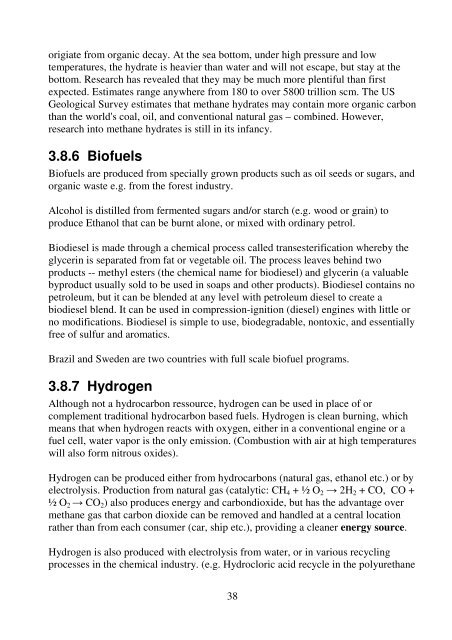Oil and gas production handbook - Process Control and ...
Oil and gas production handbook - Process Control and ...
Oil and gas production handbook - Process Control and ...
Create successful ePaper yourself
Turn your PDF publications into a flip-book with our unique Google optimized e-Paper software.
origiate from organic decay. At the sea bottom, under high pressure <strong>and</strong> low<br />
temperatures, the hydrate is heavier than water <strong>and</strong> will not escape, but stay at the<br />
bottom. Research has revealed that they may be much more plentiful than first<br />
expected. Estimates range anywhere from 180 to over 5800 trillion scm. The US<br />
Geological Survey estimates that methane hydrates may contain more organic carbon<br />
than the world's coal, oil, <strong>and</strong> conventional natural <strong>gas</strong> – combined. However,<br />
research into methane hydrates is still in its infancy.<br />
3.8.6 Biofuels<br />
Biofuels are produced from specially grown products such as oil seeds or sugars, <strong>and</strong><br />
organic waste e.g. from the forest industry.<br />
Alcohol is distilled from fermented sugars <strong>and</strong>/or starch (e.g. wood or grain) to<br />
produce Ethanol that can be burnt alone, or mixed with ordinary petrol.<br />
Biodiesel is made through a chemical process called transesterification whereby the<br />
glycerin is separated from fat or vegetable oil. The process leaves behind two<br />
products -- methyl esters (the chemical name for biodiesel) <strong>and</strong> glycerin (a valuable<br />
byproduct usually sold to be used in soaps <strong>and</strong> other products). Biodiesel contains no<br />
petroleum, but it can be blended at any level with petroleum diesel to create a<br />
biodiesel blend. It can be used in compression-ignition (diesel) engines with little or<br />
no modifications. Biodiesel is simple to use, biodegradable, nontoxic, <strong>and</strong> essentially<br />
free of sulfur <strong>and</strong> aromatics.<br />
Brazil <strong>and</strong> Sweden are two countries with full scale biofuel programs.<br />
3.8.7 Hydrogen<br />
Although not a hydrocarbon ressource, hydrogen can be used in place of or<br />
complement traditional hydrocarbon based fuels. Hydrogen is clean burning, which<br />
means that when hydrogen reacts with oxygen, either in a conventional engine or a<br />
fuel cell, water vapor is the only emission. (Combustion with air at high temperatures<br />
will also form nitrous oxides).<br />
Hydrogen can be produced either from hydrocarbons (natural <strong>gas</strong>, ethanol etc.) or by<br />
electrolysis. Production from natural <strong>gas</strong> (catalytic: CH 4 + ½ O 2 2H 2 + CO, CO +<br />
½ O 2 CO 2 ) also produces energy <strong>and</strong> carbondioxide, but has the advantage over<br />
methane <strong>gas</strong> that carbon dioxide can be removed <strong>and</strong> h<strong>and</strong>led at a central location<br />
rather than from each consumer (car, ship etc.), providing a cleaner energy source.<br />
Hydrogen is also produced with electrolysis from water, or in various recycling<br />
processes in the chemical industry. (e.g. Hydrocloric acid recycle in the polyurethane<br />
38
















